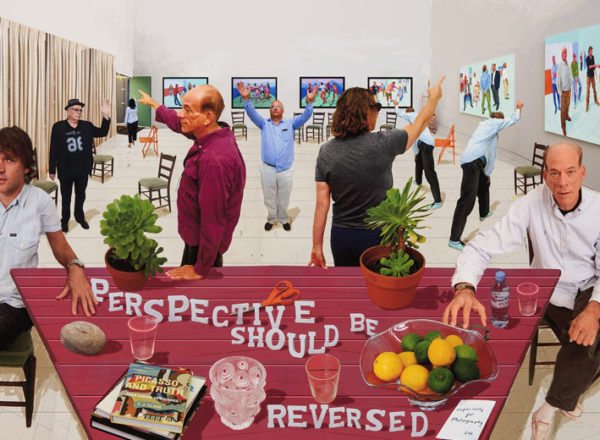


Photographic drawing printed on paper, mounted on Dibond – Edition of 25
107 x 176 cm
Ed. 13/25
Work acquired in 2016
David Hockney
Born in 1937 in Bradford (Great Britain), David Hockney lives and works in Los Angeles (United States).Graduated from the Royal College of Art, London in 1962.Represented by the galleries Annely Juda Fine Art (London), L.A. Louver (Los Angeles), Pace (New York) and LeLong (Paris).
This photograph represents a group portrait associating multiple figures and subjects in the style of a puzzle or collage. The walls of the vast exhibition space, where the image is located, are themselves covered with group portraits painted by David Hockney, producing an effect similar to a mise en abyme. A table, represented from above, with different objects—vases, glasses, green plants, a bowl of fruit—can be seen in the foreground of a complex and charged composition. The chairs, as well as the figures, with fixed poses, designate different directions in space. The title sentence ‘Perspective should be reversed’ appears on the table and in a sense, acts as the ‘user manual’ to reading the work, a manual supplemented with a handwritten note: ‘especially in photography’. Here, David Hockney combines hundreds of images to produce a single one. Multiple vanishing points, linked to the source images, strangely coexist within a single vision. The artist therefore aims to go beyond the usual flatness of photography and to free his work from the constraints of traditional representation, creating, in his own words, a ‘3D photograph that doesn’t require glasses’. This interior scene is the result of a series of ‘photographic drawings’ executed by David Hockney in his studio in Los Angeles in 2014 and 2015. It is a manifesto on the subject of perspective in art, from painting to photography. It challenges the viewer’s perception by plunging him into the painting.
David Hockney is a world famous British artist. A painter and photographer, he first developed a name for himself as a European Pop artist. Unlike the avant-garde trends that influenced his time and his peers, from Abstract Expressionism to Conceptual Art, he has developed a skilled and audacious form of figurative painting, which resonates with many historical trends—Egyptian art, for example—and with other artists—namely, Pablo Picasso. Hockney considers his art to be narrative and autobiographical, identifying himself from the beginning of his career as a homosexual artist, against the conventions and social norms of his time. Settling in California in 1964, David Hockney became a painter of a hedonistic and laidback lifestyle, as reflected in his swimming pool series (A Bigger Splash, 1967). From representations of his relatives (large double portraits) to landscapes (such as the Grand Canyons), his prolific work oscillates between the United States and the region of his birth, Yorkshire, in the north of England. He has continued to question himself, experimenting with new techniques and processes—the Polaroid, digital tablet, photocopier—to better renew his exploration of pictorial representation, which he also examines on a more theoretical level through his writings.